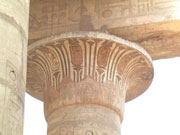TOUR NEWS - MOROCCO DECEMBER 2013 � JANUARY 2014
On the 22nd December 2013 I left Australia with my able assistant Ian Casey for a reconnaissance of Morocco in preparation for the inaugural B.C. Archaeology tour in October 2014. We flew on Etihad airways and had a very good flight - this was made particularly memorable by the fact that as we boarded the flight in Abu Dhabi for the onward trip to Casablanca we were accompanied by 12 falcons who sat in the back row of the plane on short wooden stands! I suppose that's one way for birds to fly!
We were met at Casablanca airport as arranged and transferred to our hotel in the city of Rabat, located about 1 and half hours to the north. Our hotel was the Riad Dar Zouhour, a residential courtyard house which has been converted into a small pension. It had a very attractive courtyard with a Christmas tree in the corner to give it a festive atmosphere. The hotel lay just within the medina, the old city of Rabat. We went for a walk through the narrow streets of the old walled city to the Kasbah, the fortified royal compound. The Kasbah has impressive walls and a monumental gate. We walked through the old streets of the Kasbah, wandered through the tranquil Andalusian Garden and adjoining royal residence which has beautiful tile work and inscribed wood � today it houses a small museum of ancient and mediaeval Bedouin jewellery. There was a wonderful view up the River Bouregreg, once the haunt of pirates in mediaeval times. We also walked up Consul Street through the markets where we saw ceramics and an array of other goods for sale.
 |
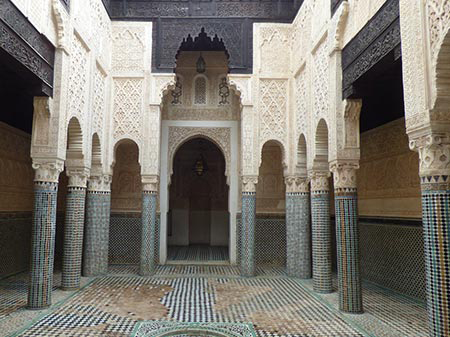 |
The Kasbah of Rabat |
The medersa of Sale |
The following morning, Christmas Eve, we walked along the Andalusian Walls which surround the southern part of the old city. We walked to the river's edge where there was a wonderful view back to the Kasbah which guarded the approach to the river. We climbed the hill to see the ruins of the Mosque of Hassan, today guarded by mounted ceremonial guardsmen. We also visited the tomb of Mohamed V (who died in 1961), a very richly tiled and carved space above the king�s sarcophagus. We had a pleasant tagine lunch near the Railway station in the Ville Nouvelle before heading along the Almohad walls of the medina to see the Bab Ruah, an impressive city gate which has now been converted into an art gallery. We then walked to the Great Mosque (like all mosques in Morocco closed to non-Muslim tourists) and along the edge of the Royal Palace until we came to the southern Almohad walls of Rabat.
We walked down to the Chellah, the 13th and 14th Century Merenid royal cemetery located within enormous walls and entered via a wonderfully decorative gate. Once inside you feel as though you are in another world. The space is a serene garden surrounding the ruins of the ancient Roman settlement of Sala Colonia � remains include the forum area with shops and ruins of a temple to Jupiter. We explored the 13th Century zaouia, a mediaeval Islamic monastery with beautiful tile work decorating the central courtyard, and also the ruined mosque crowned with stork nests. In the late afternoon we walked along the Almohad walls of the medina which were glowing orange in the light of the sunset. That evening we had a pleasant meal in a converted house (riad), our treat for Christmas accompanied by a good Moroccan red wine.
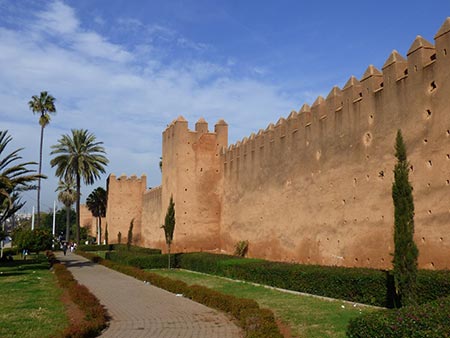 |
 |
The walls of Rabat |
The Roman ruins inside the Chellah |
On Christmas Day we went to the Archaeological Museum - what more could an archaeologist ask for! It has a small collection of artefacts showcasing Moroccan history, the most impressive objects being the wonderful Roman bronzes from the site of Volubilis including representations of King Juba II and Roman politician Cato the younger. The afternoon was wet so we spent it mostly in the hotel. On the 26th December we walked back over to the Kasbah and then down to the beach - there was a wild surf as the last of an Atlantic storm passed through. We caught a taxi over to Sale, Rabat�s twin mediaeval walled city across the Bouregreg River. The city is surrounded by walls pierced by impressive gate. We walked through the centre of the town, via the souqs, until we came to the Great Mosque (closed to non-Muslims) and saw the wonderful 14th Century medersa (college) built by Merenid Sultan Abu el-Hasan. This is very well preserved and has wonderful tiles, intricate cut plaster work and carved cedar woodwork. The college is surrounded by rooms for the students. From here we walked towards the sea, the area outside the walls being dominated by the cemetery down to the sea. There was a very rough surf and we were covered in salt spray. On our walk back we saw the River Gate where the Sale pirates used to bring the ships into the city. We caught the tram back to Rabat then walked through the souqs back to our hotel. In the evening we went to a tagine restaurant where we had a pleasant meal � a very sweet lamb and prune tagine.
The following day we caught the train northwards to the late medieval city of Meknes - the train trip was very pleasant and took us into the hills through green fields. Meknes has a wonderful bustle and energy and is very evocative of bygone times. We caught a taxi from the Ville Nouvelle (the typical early 20th Century French quarter outside the medina) to the central square (Place el-Hedim). In front of us was the wonderfully ornamented 17th Century Bab Mansour, the main ceremonial gate into a massive royal complex built by Alouite Sultan Moulay Ismail. We explored the area around the royal palace (still used and thus not accessible), capturing glimpses of the Royal Golf Course behind high walls. We walked to the Heri es Souani, enormous vaulted storerooms used to stock provisions, and saw the nearby monumental pool. We caught a horse and carriage back to the Mausoleum of Sultan Moulay Ismail, a serene tiled complex of courtyards leading to the Sultan's tomb. Back in the centre of the walled medina we visited the stunning Dar Jamai, considered one of the finest late 19th Century Palaces in Morocco. It was built by the then Vizier and has since been converted into a Museum of Moroccan pottery, woodwork and carpets. The gardens of the villa are very serene but the highlight was the gorgeous upper reception rooms with intricately carved wooden ceilings and tile work. In the evening we returned to Rabat to pick up our luggage and then made our way to Casablanca.
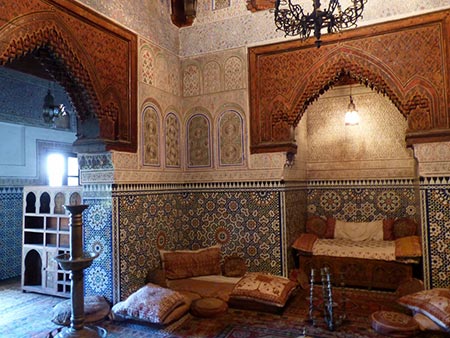 |
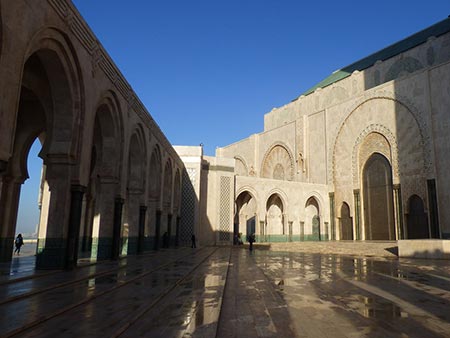 |
The Dar Jamai Palace in Meknes |
The Hassan II Mosque in Casablanca |
The 28th December was wet and cool in Casablanca (the town was more grey than white). We took a taxi downtown to the area of the old medina and went for a walk through the new city to see the 'mauresque' architecture of the colonial era around Place Mohamed V. The public buildings in the area (including law courts, bank, and post office) were built in 1920�s Art Deco style combining elements of traditional Moroccan style. The abandoned and forlorn Cathedral of Sacre Coeur had a leaky roof and an air of dissolution. The wet afternoon was spent in the medina markets, bookshops along Avenue Hassan II, and in a caf� near the medina watching the world go by. In the evening we had a pleasant meal at L�Etoile Centrale, a nice Moroccan restaurant with traditional style interior.
In the morning the sun came out and there was blue sky for our visit to the monumental Mosque of Hassan II, located on the very end of the headland looking out into the Atlantic. This enormous building was opened in 1993 and is built of hard stone and titanium to cope with the elements. The interior, while capable of accommodating 25,000 worshippers, is somehow claustrophobic particularly with its noisy guided tours. From here we left Casablanca, heading back north again, this time via the back road to Meknes. We stopped for a short refresh in Rabat and then headed on our way back to Meknes to see the things we hadn't had time to see before.
On the 30th December we had a long walk through the medina of Meknes - the heart of the old city is incredibly atmospheric with its noise and smells, and air of industry. We walked through narrow lanes of craft shops and could not pass up a vibrant shawl to be used as a tablecloth. Our road took us to the wonderful Medersa Bou Inania, a stunning 14th Century residential college with exquisite carved cedar woodwork and elaborate tile work. From here we walked into the medina with its covered suqs and decaying funduqs (old inns for caravans) most of which seem to be still used for manufacturing goods sold to locals - we were invited in to see some old men using simple horizontal looms for weaving. We walked round the walls of the medina and saw the northern gates. Once we were outside the walls the green fields spread into the distance beyond the walled cemeteries (which surround most Moroccan cities). Back in the town we had a camel burger for lunch (tasty!) and experienced the local colour of streets far from tourist haunts.
We then headed north of Meknes through green countryside past the holy city of Moulay Idris (founder of the first Muslim Moroccan Dynasty) to the Roman site of Volubilis. This lies on a raised area of ground overlooking a rich agricultural valley. This was one of the most important Roman cities in Morocco and has been extensively excavated. The centre of the ruins is dominated by an impressive Forum with Capitol (Temple to Jupiter), Basilica and Triumphal Arch. We walked through the main town to see a number of impressive ancient houses with mosaics still in situ. Scenes on display included Orpheus taming the animals, Bacchus drawn by Panthers, Dionysios discovering Ariadne, Dionysios and the Four Seasons, the cortege of Venus, Diana Bathing, and the Abduction of Hylas by the Nymphs. We then continued north through agricultural country, stopping to buy some oranges before arriving in the scenic hill town of Chefchouan, located in the Riff Mountains.
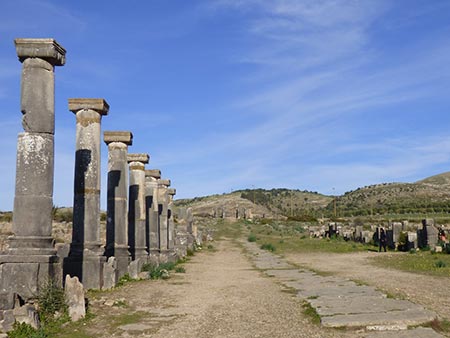 |
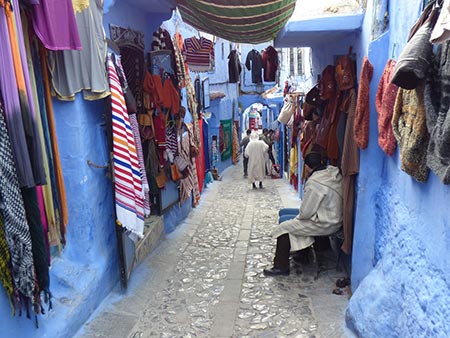 |
The ruins of Volubilis |
The markets of Chefchouan |
Chefchouan is a small walled medina located near a spring in the hills (and once a major stop on the hippy trail). Our hotel lay outside the walls and had beautiful views of the town and the surrounding mountains. We went for a walk in the area and explored the medina which is famously painted blue throughout. It was pleasant to sit in a caf� opposite the small walled Kasbah in the centre of town and watch the world pass by. The streets were full of interesting shopping opportunities including carved wooden masks and doors from Mali and locally made metal work. It was New Year's Eve and our hotel organised a meal and some dancing with the other guests - a fun evening was had by all.
The following morning (New Year's Day) we caught a bus from Chefchouan to the wonderful mediaeval city of Fes - on our journey south we quickly left the mountains behind and then travelled through green fields and olive groves. We checked into our hotel in Fes, a very pleasant pair of Riads (traditional courtyard houses). We stayed in the smaller of the 2 houses but used the courtyard of the larger one for meals and relaxing. We went to the nearby Palais Jamai Hotel (a revamped Vizier�s Palace with wonderful gardens) for a cocktail on the roof terrace and watched the sun set over the ancient medina - magical! What a great way to start the year!
On the 2nd January we explored the town. We went first to Fes el Jedid to see the gates of the Royal palace and the Jewish Quarter (called the Mellah, each Moroccan town had a dedicated Jewish area, but most Jews have now left). We then went to the South Borj, a military fortress on a hill to the south of the city with spectacular views over the city. From here we saw the imposing walls of the city and stopped to visit a pottery and tile manufacturer who showed us how they made the impressive tiles used to decorate house walls and also saw the manufacture of painted pottery. After this we entered the old medina which felt like stepping back in time. The streets were busy with locals who were shopping at small businesses for fruit and meat (the butcher�s shop was marked by camel heads hanging at the front!). We made our way to the dyers quarter and the pungent tannery vats - leather hides are still coloured here in the traditional manner. We had a pleasant lunch in a restored riad and then wandered round the historic quarter surrounding the enormous Kairouine Mosque, the heart of the city. We saw the superb 14th Century Medersa Attarine, a beautiful residential college for students studying at the Mosque and saw the outside of the richly decorated Tomb of Moulay Idris II. We also saw a silk workshop where fabrics were being made on horizontal looms.
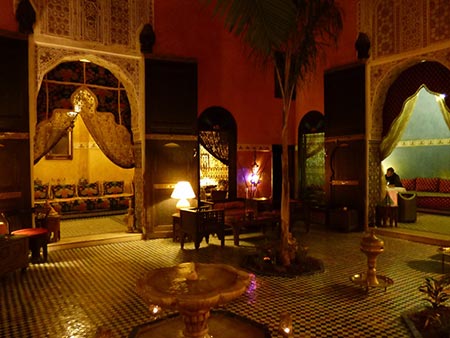 |
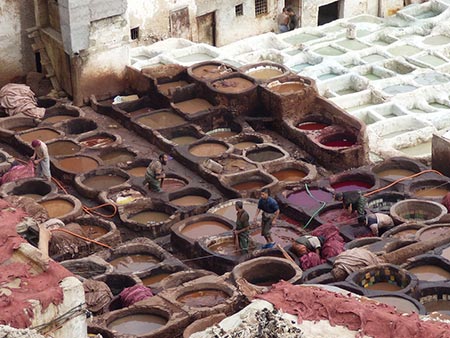 |
Our Riad in Fes |
The tanneries of Fes |
The following day was also spent in the Fes medina. We started at the Kasbah en Nouar, the fortified royal enclosure with its impressive gates, and then walked along the massive walls of the city near Bab Mahrouk. From here we walked to the Musee Batha, housed in the 19th Century Palace of Hassan I � it contains an interesting collection of pottery and embroidery displayed in rooms around a peaceful garden. We then walked from the richly ornamented Bab Boujeloud down through the suqs (remarkably, Fes is built in a bowl-like valley surrounded by hills with streets descending steeply to the heart of the city near the river) to the Medersa Bou Ianania, another wonderful example of a richly ornamented 14th century residential college with a large prayer hall. We passed a number of old funduqs (caravan lodges) and had lunch in a restored riad (courtyard house). In the afternoon we visited the ruins of the 14th Century tombs of the Merenid Sultans, which have a superb view over the city, and also saw the collection of medieval weapons and tools in the North Borj, an impressive fort guarding this side of the city.
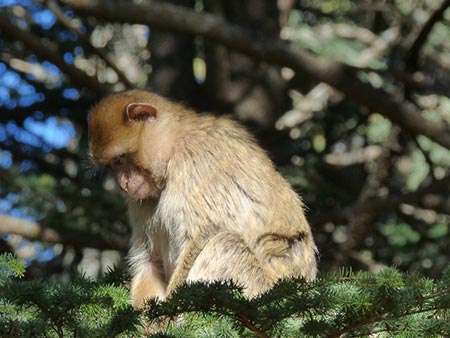 |
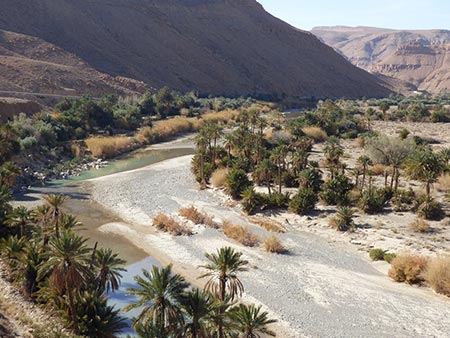 |
Macaques in the cedar forests |
The Zis Valley |
On the morning of the 4th January we left Fes, heading off with a sense that many more days would be needed to really absorb the countless wonders of the old city. We headed south through farmland before heading up into the Middle Atlas Mountains, stopping for a coffee in the alpine village of Ifrane. We entered the cedar forests of the Middle Atlas, stopping to photograph the wild Barbary apes, a species of macaque. Attracted by the fruit offered by passing travellers, the apes come down close to the edge of the forest. From here we passed into increasingly barren and dry country following stark river valleys. After crossing the pass we descended onto the dry desert plain between the Middle and High Atlas Mountains, the later covered in drifts of snow at the higher altitudes. We stopped for lunch in a very pleasant hotel and saw a large collection of fossils and minerals for sale in the adjoining shop. Our journey then continued to Midelt where we went for a walk along the edge of an impressive desert gorge leading down from the Jebel Ayachi Moutains, passing through a local village.
The following day we headed along the edge of the High Atlas across the desert plain before ascending via a desolate canyon to the pass over the High Atlas. Our path took us into the wonderful Zis River Valley. This begins as a palm fringed rivulet and opens into a broad valley with extensive palm gardens and small villages perched on the valley edge � we had a very pleasant lunch with views overlooking this ribbon of oasis. In the afternoon we stopped to see some more fossil shops near Erfoud (famous for its 200 million year old trilobite fossils) before heading out to the settlement of Merzouga on the edge of the Erg Chebbi desert. Our wonderful hotel was located at the edge of the Dune Sea, the northern edge of the Sahara. In the light of the late afternoon sun we went for a long walk out into the red dunes, enjoying the site of tourist groups heading out on camel back, some of them staying overnight in a permanent camp in the dunes. It was truly magical to see the sun set behind 150m high dunes and explore the desert as the moon rose high over the wilderness.
 |
 |
The dune sea at Merzouga |
Todra Gorge |
On the 6th January we enjoyed watching the sun rise over the desert dunes before heading west towards the Todra Gorge. On the way we stopped to walk through some disused desert 'qanats', manmade subterranean channels bringing spring water down into the oasis towns. We stopped to visit the fortified desert town of Khorbat where the houses are encircled by battlements. The streets were largely covered by the houses leaving darkened avenues protecting residents against the heat of summer. We saw the Musee des Oasis, a collection of Berber artefacts and photos housed in three restored houses. Our journey then took us through the Tinghir Palmery, past numerous mudbrick villages and Kasbahs, to the Todra Valley where we stopped for a pleasant lunch in a traditional house. A guide then took us for a walk up the Todra Valley through lush gardens to the impressive Todra Gorge, a narrow valley through which the river flows. A number of rock climbers were scaling the vertical walls at the upper end of the Gorge. Later in the afternoon we continued our journey to the Dades Gorge, where we stayed two nights in the very pleasant Xaluca Dades Hotel, with views over the valley and the town of Boumalne du Dades.
The following day was spent exploring the wonders of the Dades Valley which leads up into the High Atlas Mountains. We headed down into the town where they were holding their weekly market in the central square - they were catering mainly to the needs of the local populace but there were also some antique jewellery stalls. We then drove up the valley, stopping to look at a number of fortified kasbahs often located at the convergence of valleys. We passed through some rugged landscapes where the local limestone was tilted on its side and heavily eroded (the Monkey Rocks). We then walked up through the narrowest part of the impressive Dades Gorge (only a few metres wide) before returning to the centre of the valley for a pleasant lunch overlooking the fields. In the afternoon we walked through the orchards and fields to a pair of old kasbahs dominating an area of rich agricultural fields.
On the 8th January we continued our journey westwards, passing through desolate country between the High Atlas and Anti-Atlas ranges, each village dominated by its own Kasbah. In the afternoon we arrived at Ait Ben Haddou, a spectacular fortified city with impressive stone Kasbahs. The settlement has often been used as a film set in movies such as 'Lawrence of Arabia' and 'Kingdom of Heaven' (and more recently in 'Game of Thrones'). We walked across the dry river bed and then ascended to the summit of the hill through the rows of streets. That evening we attended a Moroccan cooking demonstration at our hotel and enjoyed the local cuisine; chicken and preserved lemon tagine with couscous.
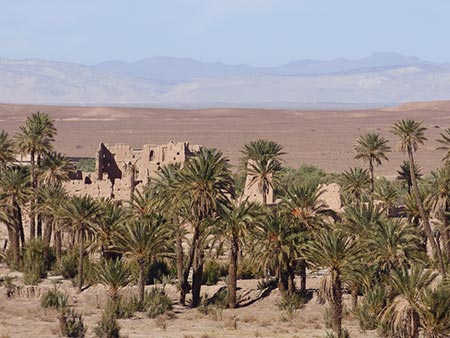 |
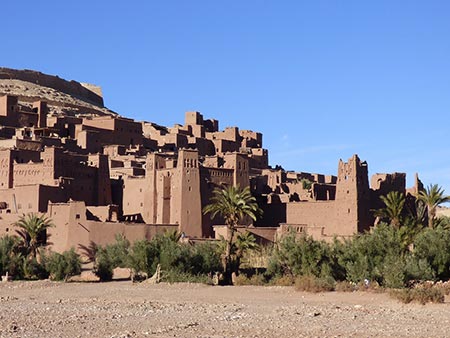 |
Desert Kasbah |
Ait Ben Haddou |
The next day we made our way up and over the High Atlas Mountains, following a winding valley past a number of villages in a desolate valley. We then continued up to the Tizi n'Tichka Pass which lies at 2260 m above sea level. The area is usually under heavy snow by January, but this had been a very dry year and there had been virtually no snow (possibly to be blamed on climate change?). Only the mountain summits nearby had any snow. When we ventured out of the bus at the top of the pass for an obligatory photo stop the cold icy blast reminded us that this was mid-winter. As we descended we began to pass through alpine woodland and then agricultural fields, a completely different environment to the slopes on the other side of the Atlas which receives far less rain. We headed on to Marrakesh where we checked into our riad in the centre of the medina and had lunch in a restaurant overlooking the Jemaa el Fna, the main square of the city and centre of life in the old city. We could see the snake charmers and macaques keepers, traditional medicine sellers and barrows and carts, producing an image of life from a medieaval world. We went for a walk through the suqs where traditional crafts are still maintained, including the use of a hand held bow drill for making wooden objects. We had dinner in the main square (which becomes a mixture of open air theatre and restaurant at night) and enjoyed a mysterious spice drink which was said to cure all ills.
The 10th January was spent exploring some of the many wonderful sights in Marrakesh. Our day began with the Maison Tiskiwin, an early 20th Century riad which has been converted into a museum celebrating the arts and crafts of Mali and containing many interesting carved wooden objects. We then went to the Bahia palace, a 19th Century mansion belonging to a Vizier. It contains a number of courtyards and has wonderful inlaid wooden ceilings. We stopped to see a business selling tradition Berber medicine using natural plant products, and saw the tombs of the 16th and 17th Century Saadian Sultans. The various tomb chambers and oratories are richly decorated with tile work and have impressive carved wooden ceilings. We then walked around the walls of Marrakesh, stopping to see the impressively decorated Bab Agnaou, one of the entrances into the Kasbah of the city.
In the afternoon we walked through the wonderful suqs of Marrakesh to the Ben Youssef Medersa, a restored 14th Century school residence. Lavishly decorated with tiles, woodwork and cut plaster, it has a large reflecting pool in the centre of the court. The upstairs rooms are more extensive than any other we had seen in Morocco and suggested the life of a medieval student. Across the road was an Almoravid kiosk (or koubba), part of a mosque dating back to the 13th Century. Nearby we also saw the Marrakesh Museum which is housed in a restored 19th Century mansion built by the then Defence Minister. It contains a diverse collection of Moroccan art including ceramics, Jewish objects and metalwork. The private hamman (steam bath) of the house is very well preserved. In the evening we had a very pleasant meal in the Ville Nouvelle (the modern French town).
 |
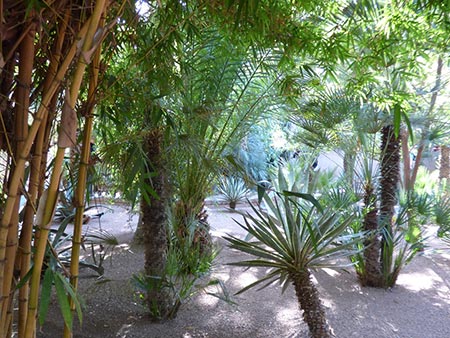 |
Snake charmers in the Jmaa el Fnaa |
The Marjorelle Gardens |
The next day we were joined by Paul and Diane Casey (Ian's parents) who came over from England for a week. Our day was devoted to exploring the further wonders of Marrakesh. In the morning we started with the splendid Dar Si Said Palace which was built in the 19th Century and which houses an interesting collection of artefacts, but it is the house itself which attracts most attention. It is built around a beautiful garden and the reception rooms have the most stunning wooden ceilings we had seen. From here we walked back up to the Jemaa el Fna square and walked around the outside of the Koutoubia Mosque, built by the Almohad Dynasty in the 12th Century. Non-Muslims are not allowed inside but the architecture is impressive and part of the ruined courtyard can be seen. We then caught a cab to the Majorelle Gardens, a 12 acre botanical garden created in the 1920 and restored by Yves Saint Laurent in the late 20th Century. It is very tranquil and cool with areas dedicated to palms, cacti and bamboo, and the pavilion houses an outstanding Museum of Berber artefacts including jewellery and cloth. We walked back to the medina, the city walls illuminated by the glow of the setting sun. We entered via Bab Doukkala and walked past many old funquqs (camel caravan lodges) on our way to our hotel.
On the 12th January we arranged for a small bus to take the 4 of us down to the coast where we spent time exploring the fortified city of Essaouira (anciently called Mogador). We stopped to take the obligatory photos of the argan trees upon which the local farmers have trained their goats to climb. We also stopped to see an argan oil production centre and Diane had a go at grinding the seeds into the valuable cosmetic paste used in cosmetics. We continued on to Essaouira, an 18th Century fortified port where we walked round the harbour and looked at the boat building yards. Inside the Marine Gate we were soon tempted by the wonderfully fresh seafood � we had a large platter of prawns, calamari, crab, snapper and dory. We then walked through the medina, looking at the shops where I bought a wooden box made of thuya, a native tree of the region. We walked up to the North bastion with its great views along the walls protected by many cannons still pointing out to sea. Off the shore we could see the Iles Purpuraires, where Phoenician settlers had produced the famous purple dye made from crushed murex snails. In the afternoon we returned to Marrakesh, passing through a broad desert plain before arriving back at the medina.
On the 13th January we left Marrakesh and headed up into the Atlas Mountains to the small alpine village of Imlil. We stayed 4 very pleasant nights at the Riad Dar Imlil, a walking lodge with very comfortable rooms and splendid views of the snowy mountains and villages higher up in the range. That afternoon the 4 of us went for a walk, following a winding path upwards to the village of Aroumd in the stunning Mizane Valley, located at a height of 1840m. Ahead of us rose the snow covered peaks above which rises Mount Toubkal, the highest mountain in Africa (4167 m) and a definite temptation to climbers and walkers like the Casey clan.
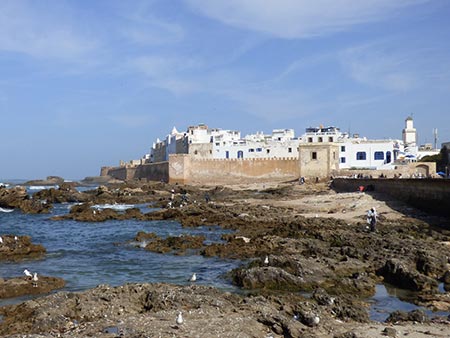 |
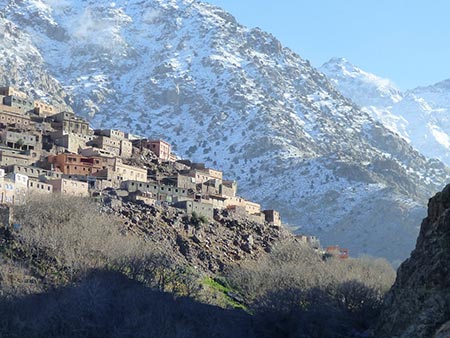 |
Essaouira |
Walking the High Atlas - the village of Aroumd |
The next day we set off for a climb into the snowy peaks of the Atlas. Paul had arranged a guide to lead him further than the rest of us intended to venture and the two of them set off at pace, soon leaving the 3 of us behind. Our path took us beyond Aroumd where we crossed a broad river flood plain full of boulders and then made our way up the mule path to the small settlement of Sidi Chamarouch, located beside a number of small waterfalls. Here is located the tomb of a marabout (Muslim saint) and a strange white painted boulder, probably the survival of an ancient Berber cult. We enjoyed a cup of tea here knowing that Paul had continued beyond the settlement into the snow, heading for the walker's refuges on the way to Mt Toubkal. We took our time to return to Imlil, observing many bird species and watching the goat herders lead their flocks through the snow (I also made a very small snowman). The views around Aroumd were stunning.
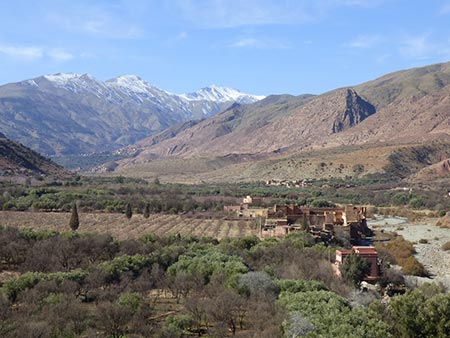 |
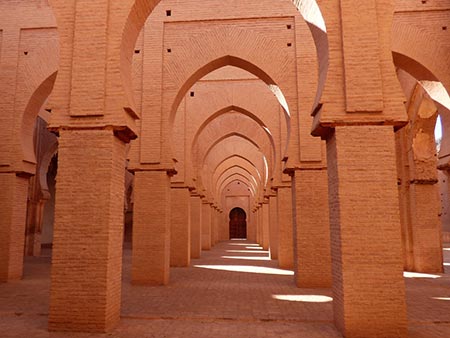 |
The Nfis Valley |
The Tin Mal Mosque |
The next day we took a break from hiking and instead organised a car to take us up the Nfis Valley for some walking. We passed though small towns and ascended via a scenic winding road to the town of Ijoukak where our cup of tea was accompanied by stunning views across green agricultural fields up to the snow covered mountains. The driver left us at the start point of a walking trail and we hiked a few km up the increasingly desolate valley to the impressive Tin Mal Mosque. This enormous building was erected by the Almohad Dynasty in the mid 12th Century as part of a now-ruined urban centre. The mosque is long disused (although part has been restored) and is interesting to explore. Our path then continued by car up a winding path to the Tizi n�Test Pass which at 2100 m provides a splendid view across the Souss Plain to the dark volcanic Anti Atlas Mts beyond. In the far distance lay the impressive walled 16th Century city of Taroudant. However this tempting but distant place will have to wait for a future visit ....
The following day everyone else went off for a walk from Imlil towards the village of Tamatert but I piked out and had a day of rest, taking some time to post ever more photos on Facebook. It was pleasant to do nothing for a change!
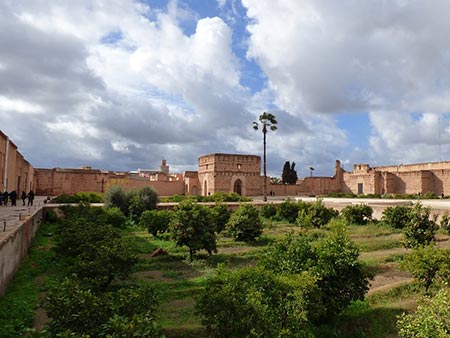 |
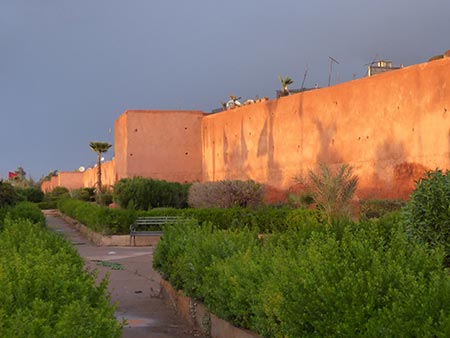 |
The ruins of the Badi Palace |
The walls of Marrakesh at sunset |
The next morning, on the 17th January, we packed out bags and headed back down the valley to Marrakesh. Paul and Diane Casey headed to the airport and then to the UK, but there were so many things that Ian and I still wanted to see in Marrakesh. We returned for another day's walking through the old quarter, passing through the infamous Slave Markets (now given over to clothes) until we arrived at the Maison de la Photographie. This is housed in an old Spanish style residence and on display were interesting photographs of Morocco from the 19th and 20th Century but the best part of the experience was the splendid view of Marrakesh from the roof terrace caf�. Our road then took us to the historic tanneries of Marrakesh (which you smell before you see!). They lie on the eastern edge of the medina near the Oued Isil River which runs along the edge of the city's walls. We passed through the Bab Debbagh, an impressive Almoravid gate with its many chicanes and walked around the edge of the city walls to the northern Bab el Khemis. The walls are well preserved here. We walked through a rundown part of town to the Zaouia Sidi Bel Abbes, a religious complex around a tomb of a local saint � this had been rebuilt by Sultan Moulay Ishamil in the 17th Century and is a real hive of energy. We saw many blind people coming to receive their handout of free food in the courtyard. We also saw a 'House Museum', a restored riad with objects of daily life on display. In the afternoon we re-visited the Saadian Tombs, located near the Mosque of the Kasbah. The tombs date form the late 16th Century and are masterpieces of tile and plaster work. In the afternoon it poured with rain and we beat a hasty retreat to our new riad located in the old Kasbah of Marrakesh. It was decorated with beautiful carpets and was home to 4 cats.
On the 18th January we had our last day in Marrakesh - although we had been there many days it somehow felt that there was so much more to discover. Just behind the Saadian Tombs, and somehow easy to walk past without being aware of the entrance, was the El Badi Palace, a massive complex of ruined pavilions built by the Saadian rulers in the 16th Century around an enormous central court with sunken gardens and reflecting pools. On display here was a famous Almoravid era mimbar (pulpit) dating from 1137. We also saw the Saadian pleasure gardens and enormous reflecting pool known as the Menara Gardens - the pavilion was backed by the pale shadow of the Atlas Mountains and enormous storm clouds. We returned to the Kasbah at sunset, the afternoon raking light making the walls of Marrakesh shine bright orange to stunning effect.
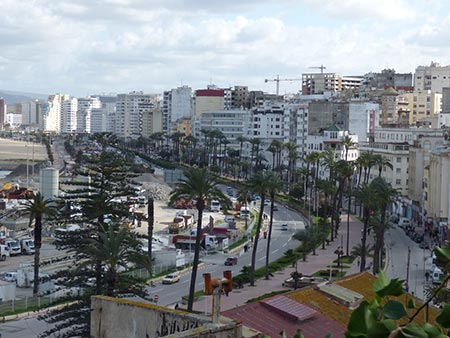 |
 |
The sea front at Tangier |
Roman mosaic on display in Tangier |
That evening we took the overnight sleeper train from Marrakesh to Tangier, a journey of about 9 hours. We had a first class cabin which was perfectly comfortable and to our surprise we actually felt rested when Tangier Station appeared in front of us. We checked into the Atlas Almohad Hotel which was comfortable and right on the beach. We had a view across the Straits of Gibraltar to Spain and the far off town of Tarifa. Once we had checked in we went for a walk along the shore to find a coffee (a definite priority) and then walked to the ancient medina which is being restored, with much new work on the sea walls. We entered the medina near the Grand Mosque and proceeded to the Petit Socco, famous for its association with the Beat generation author William Burroughs and local literati Paul Bowles. We then climbed through the medina to the Kasbah (fortified citadel) which has wonderful views over the Straits. We visited the Royal Palace which is now the Museum of Antiquities - it has excellent displays of objects from Roman and Islamic times. We walked down to the Grand Socco via the supposed tomb of the great Arab traveller Ibn Battuta, walked through the covered markets and saw the extensive Jewish Cemetery outside the southern walls of the medina. The afternoon was spent people watching in Place de France, famous as the rendezvous point for spies during World War II.
On the 20th January we took a share taxi to the hill town of Tetouan, nestled in the foothills of the Rif Mountains. Far from the standard tourist trail, the ancient medina has a very traditional feel. We arrived in the Ville Nouvelle which was erected by the Spanish in the early 20th Century and there explored the numerous Art Deco buildings. The Archaeological Museum had a good collection of Roman mosaics from the sites of Volubilis and Lixus. We then went for an extended walk through the medina - this dates largely from the 15th Century, founded when the persecuted Muslims and Jews were expelled from Spain. The suqs were very traditional and largely catered to the local population selling meat, fruit and vegetables, and cloth. We ascended the hill to the Kasbah and then walked around the external wall of the medina near the extensive cemetery, entering the town again via the Bab Sebta and exploring the traditional tanneries dying leather in vats of chemicals. We also explored the interesting Mellah (Jewish Quarter) and saw a number of traditional houses. The Ethnographic Museum near the eastern gate of the medina had a very good collection of objects from daily life.
 |
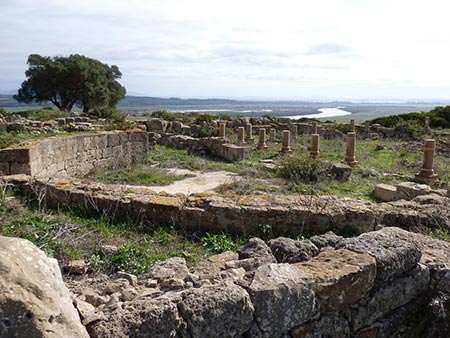 |
The walls of Tetouan |
The ruins of Lixus |
The following day we took share taxis south of Tangier to the ancient site of Lixus. This has its origins in prehistoric times and was subsequently inhabited by the Phoenicians and Romans. The site is located on a flat topped hill overlooking the meanders of the Loukos River. We followed a well-defined path up the hill, exploring the impressive Roman remains which included: fish salting vats near the river, the theatre (later converted into an arena for wild animal shows), baths, temples, extensive housing quarter, forum with basilica and a number of temples. We then had lunch in the small town of Larache and explored its small ruined fort, and after that made our way back along the coast to the town of Assilah where we went for a walk in the atmospheric medina and Kasbah. The walls are predominantly painted blue and white giving a very Mediterranean feel to this Atlantic base.
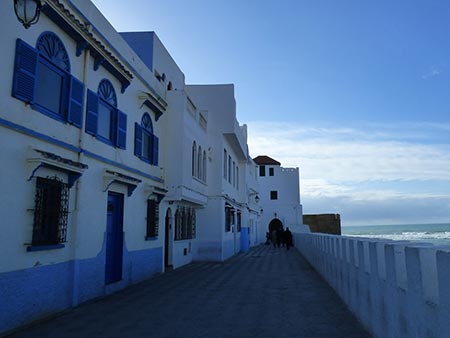 |
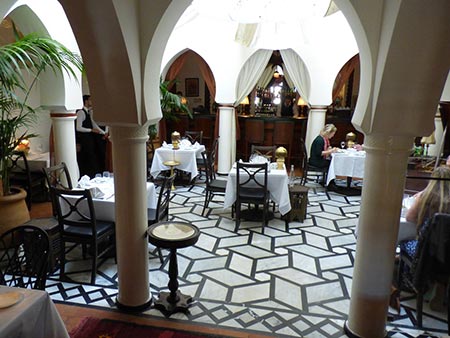 |
The beautiful town of Assilah |
'Rick's Caf�' in Casablanca |
On the 22nd January we travelled south of Tangier by train to Casablanca. We checked into our hotel near the Medina and went for a walk. The following morning (our last day in Morocco) we caught a taxi to the southern suburbs of Casablanca to see the interesting Museum of Moroccan Judaism. This private museum has an impressive collection of books, scrolls, silver objects and synagogue furniture. There is a good collection of photographs documenting the history of Judaism in Morocco as well as a reconstructed jewellery workshop. In the afternoon we walked around the Art Deco quarter and had a very pleasant lunch in Rick's Caf�, a clever evocation of the famous cafe from the movie 'Casablanca'. We then headed to the airport for our return flight to Sydney.
Our month in Morocco had allowed us to explore the country and its imperial capitals, Roman cities, Islamic monuments and diverse landscapes including the wonderful dunes at Merzouga. We returned with many wonderful memories of a fascinating and historic country.
Michael Birrell
